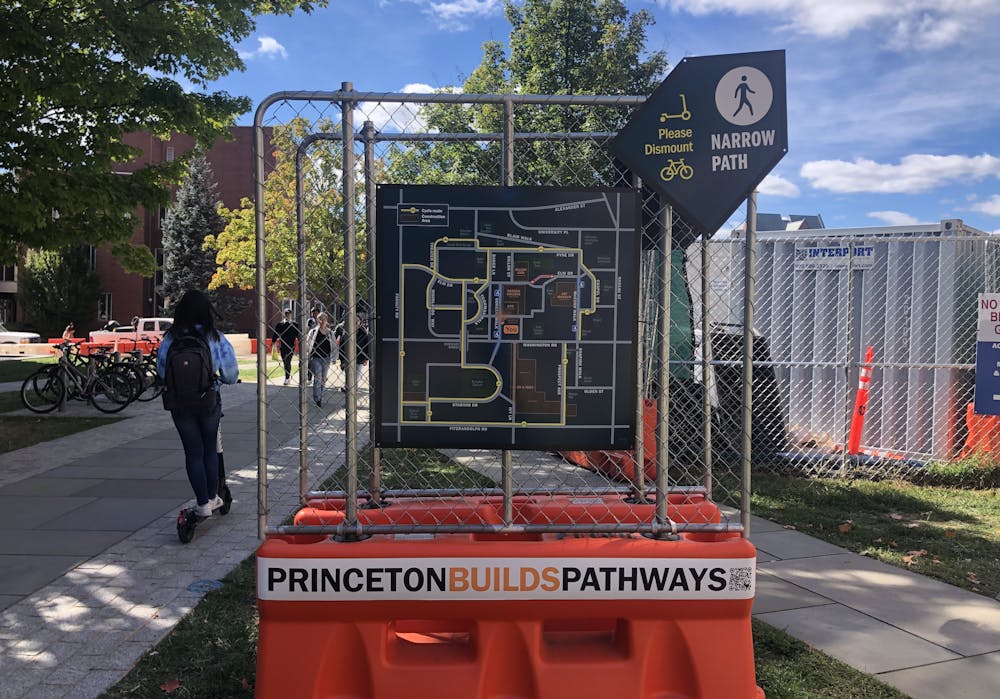Living in New College West, I dread my 8:30 a.m. math lecture. Not only is it hard to get out of bed so early, but more importantly, walking up the hills of the Princeton campus to get to Fine Hall is a daunting task for a sleepy person. However, my experience is nothing compared to those who experience physical disabilities. I am not disabled.
While I may consistently complain about this uphill trek, I am not the one who is most negatively impacted on Princeton’s campus; those who are physically disabled are most affected by Princeton’s lack of accessible routes across campus. There is a pressing need to implement new systems that make it easier for people with disabilities to navigate campus.
As Princeton grows, construction and renovation projects further limit students’ movement around campus. It seems like half the paths around campus are cut off by orange fences surrounding massive construction sites. One assumes that these buildings, once completed, will be more accessible than the existing gothic structures — many of which do not have elevators for physically disabled students. But, for now, they pose tremendous obstacles.
This is one of the most under-recognized, yet widely experienced, aspects of discrimination at Princeton. In a June 2022 Daily Princetonian feature, “Disabled students at Princeton and the ongoing fight for a more inclusive campus,” which highlighted the experience of disabled students at Princeton, the percentage of students who report mobility/medical disability as their primary disability has increased by 50 percent in the last ten years. As this percentage grows, there should also be a significant expansion of programs and methods to assist and increase belonging for disabled students.
Princeton has established some rudimentary systems to make campus more accessible. The University has set up accessibility programs specifically designed to help students with disabilities, whether physical, sensory, or mental. For example, the Office of Disability Services (ODS) was established in 2006 and is a valuable resource for disabled students. The ODS website contains a Campus Resource Guide, which helps students identify resources that can assist them with academics, transportation, and dietary restrictions. Princeton has made some reasonable efforts, but there should be more widespread assistance regarding accessibility for those who experience disabilities, whether permanent or temporary. However, establishing an Office of Disability Services is not anything to be lauded for, given that it is common across our peer institutions.
Beyond these important types of resources though, Princeton needs to continue to work on making its campus more accessible by adding more elevators or expanding its transportation assistance networks. Despite the aforementioned resources, there is no way for students to avoid the hills and stairs. As of now, the University websites do not appear to have any updates on the next steps toward increasing campus accessibility.
The last announcement concerning next steps made by ODS came out in 2020. It contained information on the new system, ACCOMMODATE, which outlines the new process for requesting accommodations to make communication between students and ODS simpler. The system has many requirements, namely putting in a request through ACCOMMODATE, getting it approved, and making an appointment. Before ACCOMMODATE, there were many different systems oriented to different parts of accommodations for people with disabilities. The course roster form was used to request accommodations from faculty, while other forms of accommodation were requested through either directly contacting ODS or the Resource Assistant Request.
While having a centralized system does make getting accommodations more efficient and easier for students to handle, the accommodation system is still slow, according to students I have spoken with. I have peers, for example, who have still not been able to get accommodations for their temporary disabilities after having been injured for weeks. Furthermore, this new announcement does not actually add any more accommodation opportunities for students, such as an expansion of ramps or a clear path to the classroom, rather it just centralizes the already existing process.

Then there is the issue of transportation: there should be more bussing systems. As of now, there are four bus routes that run throughout campus. However, taking into account both temporary and permanent disabilities, and the tight schedule of classes, four buses is not nearly enough. The University must offer more buses that run at staggered times to pick up students from different areas across campus efficiently. Other things Princeton could do is put in more accessible ramp alternatives for areas with stairs to create a better-connected campus, whether that be within buildings or by connecting separate ones.
Princeton must do more to make campus more accessible. This all begins with the University publishing next steps for how they plan on doing so.
Kabir Singh is a first-year from New York City, N.Y. thinking of majoring in the School of Public and International Affairs. He is a columnist for the Opinion section. Kabir can be reached at ks5469@princeton.edu.
Correction: A previous version of this piece asserted that The Daily Princetonian feature “Disabled students at Princeton and the ongoing fight for a more inclusive campus” was published in July 2022. It was actually published in June 2022. A previous version of this article also suggested the University create "taxi-type section of TigerTransit which could ensure safe and easy transportation for students who are both temporarily and permanently injured." The University already runs this program through TigerAccess. The 'Prince' regrets these errors.









